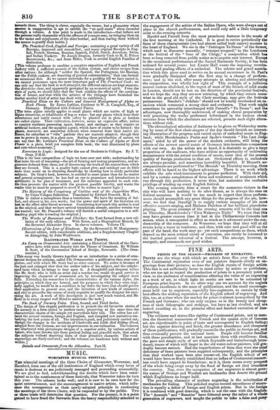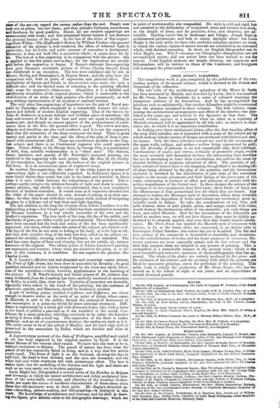FINE ARTS.
PRINTS OP THE SEASON—PROGRESS OP ENGRAVING.
Pitmen are the wings with which an artist's fame flies over the world. The Continental reputation even of our painters depends chiefly on en- gravings from their pictures; as does the English repute of foreign artist* This fact is not sufficiently borne in mind either by artists or publishers, who are too apt to regard the production of prints in a pecuniary point et view, to the exclusion of considerations affecting the value of an engraving as a work of art, in which light its merits are sure to be estimated by European print-buyers. In no other way can we account for the neglect of artistic excellence in the mass of publications, and the small encourage.. ment held out to engravers, especially line-engravers, to sustain by their best efforts the sinking reputation of the English school of engraving. And this, too, at a time when the market for prints is almost monopolized by the French and Germans; who not only surpass us in the beauty and cheap- ness of their lithographs and etchings, but have at last rivalled, and arts indeed excelling us, in the pictorial effect and finished execution of line. engraving. The coldness and statue-like rigidity of Continental prints, not to men- tion the theatrical mannerism of French and the quaint style of German art, are objectionable in point of taste and uncongenial to English feeling; but the superior drawing and finish, the greater abundance and cheapness of these publications, will gradually reconcile the pliblic to foreign art, and thus eventually pervert the national taste. People will become familiar with these peculiarities, and at last associate them with excellence: thini, the pure and simple style of art which Reynolds and Gainsborough intro- duced, traces of which still linger in the old water-colour painters, will gra- dually become extinct. Had the imperfections of form that were the chief deficiency of these painters been supplied subsequently, and the principles' that they worked upon been also conserved, the English school of art would have been so firmly established that no influx of Continental manner- ism could have sapped its foundations: as it is, there seems every prospect of the whole being swept away by the flood of foreign art that inundates the country. Nay, even the occupation of our engravers is almost gone: the names of Strange and Woollett are landmarks that denote the ground which Englishmen no longer hold. The prevailing character of modern engraving is the substitution Of mechanism for feeling. This polished engine-turned smoothness of execu- tion is equally a defect of foreign and English prints. But in the foreign it is combined with good drawing, which is not the case with the English. The " Annuals " and "Beauties" have frittered away the talent of a whole generation of engravers, and taught the public to take a false and petty eisier of the art—to regard the means rather than the end. People now look not at prints, but into them; and they mistake littleness, smoothness, sta hardness, for good qualities. Hence, all our mod. ern engravings are overcrowded with work; and this misplaced labour injures if not destroys the pictorial beauty of the print. In the last of the series of line-engrav- ings from Wilkie—The High/ander's Return, by William Finden—the general character of the picture is well rendered, the effect of reflected light in particular; but its feeble and petite manner of execution is detrimental. Moreover, it does not look like a consistent whole; it seems done bit by Mt. The test of a fine engraving is its comparison with the picture: this la applied to but few plates now-a-days, for the impressions are mostly old before the engraving is begun. F. Bacon's elaborate line-engraving from poor Duncan's admirable picture of Prince Charles Stuarts Entry into Edinburgh is an exception. The two were exhibited side by side at Messrs. Hering and Remington's, in Regent Street; and the plate bore the comparison well, both in point of expression and pictorial effect. The multiplicity of figures and details in the crowded scene made the task a difficult one; and the limited scale of colouring in the painting afforded lisle scope for engraver's chiaroscuro. Altogether, it is a faithful and satisfactory translation of the original picture; which is memorable as the chef-d'ceuvre of an artist of high promise who died prematurely, as well as a striking representation of an incident of national interest.
The only other line-engravings of importance are the pair of Royal por- traits by Partridge; which exemplify in a remarkable manner the excel- lences and defects of modern English engraving. That of the Queen, by John H. Robinson, is a most delicate and brilliant piece of execution: the tone and texture of flesh in the bust and arms are equal to anything in modern art; and though we cannot approve of the predominance of conti- nuous lines in the face, the general effect is good. The velvet and lace, ribands and jewellery, are also well rendered; and it is not the engraver's fault that the ornaments of the dress overpower the head. There is great variety and purity in the tints, and the effect of the play of lines is pro- duced with consummate skill. These are excellences peculiar to the Eng- lish school; and there is no Continental engraver who could approach them. Prince Albert, in his Hussar dress, by George Doo, is a masterpiece of bold, firm, metallic workmanship: it is "sheer steel." The flatness, finery, hardness, and opacity of Mr. Partridge's teaboard painting, are rendered in the engraving with such power, that Mr. Doo, by the fidelity of his translation, has brought out the badness of the original picture in full force. It is an unconscious piece of engraver's irony. In modern line-engravings, the value of the white paper as a means of representing light is not sufficiently regarded. In Robinson's Queen it is more freely shown than usual, but only in the hand and kerchief; in Doo's plate it is only visible between the reticulations of the graver. This is perhaps partly owing to the deficient breadth of light and shade in contem- porary painters, but chiefly to the over-elaboration that is now considered the test of finished execution. It would seem as if engravers dreaded lest the white of the paper should be seen, instead of prizing it as their sun- shine; for they shut it out with their wire-gauze work, instead of tempering its glare by a delicate veil of hair-lines and light hatching.
he last addition to the long list of prints from Edwin Landseer is a fox approaching a trap—Not Caught yet—which has been rendered in mezzotint by Thomas Landseer, in a way wholly unworthy of his own and his brother's reputation. The iron teeth of the trap, the fur of the rabbit, and the blades of grass, are alike woolly and unsubstantiaL These defects might have been excused had the look and action of the fox been significantly expressed; but these, which make the point of the subject, are slurred over. The legs of the fox do not seem to belong to his body, or to be legs at all; and that slow, sensitive drag of the bent fore-foot, which in the picture ex- pressed the stealthy, creeping motion of Reynard, is not indicated. The head has some degree of force and vivacity, but not the subtile, sly, intense keenness of the original. The salient points of Edwin Landseer's painting are expression and texture; where these are missed in the print, as is the case in this instance, it is worthless. No one engraves his pictures like Charles Lewis.
R. S. Lauder's effective but melodramatic and somewhat coarse picture, The Trial of Effie Deans, has been done in mezzotint by Bromley; its good qualities lessened and its defects heightened by the loose and sandy flimsi- ness of the execution—which, however, approximates to the handling of the picture. E. M. Ward's homely and literal picture of Dr. Johnson Res- cuing Goldsmith from his Landlady has been carefully rendered in mezzotint by Baffin, in a cold, thin, clear style. Varieties of mezzotint are desirable, especially when suited to the touch of the painting; but the extremes of glassiness, opacity, and flimsiness, should be studiously avoided.
A pair of striking prints, entitled Confidence and Diffidence, are clever enough to deserve notice as the work of an artist of talent, whose name, R. Hannah, is new to the public; though the contrast of demeanour in two messengers is a point too trivial for grave pictorial treatment. Diffi- dence is represented by a timid girl with downcast looks, who, with a letter in her hand, is pulling a gate-bell as if she trembled at the sound; Con- fidence, by a saucy post-boy, whistling carelessly as he raises the knocker to bring it down with a loud rap. The expression of the faces is rather tutificial; and an air of consciousness destroys the sentiment, such as it is. The artist seems to be of the school of Mediae; and his hard edgy style is Preserved iii the mezzotints by Bellin, which are forcible and clear in execution.
A daguerrdotype portrait of the Duke of Wellington, amplified and copied an oil, has been engraved in the stippled manner by Ryall. It is the truest likness of the veteran chief extant. We have here the man as he is, without caricature or flattery. The pencil of nature has done what the pencil of art has repeatedly failed in doing, and in a way that few artists could equal. The focus of light is on the forehead, showing the face in half-tint; the head is bent forward, and the eyes are downcast; and the White hair and white waistcoat tell with picturesque effect. The face is rather dark; but the modelling of the features and the light and shade are such as we very rarely see in modern paintings.
Louis Haghe has lithographed a second series of his Shtches in Belgium and Germany; in which the quaint architecture and richly sculptured into- flora of the town-halls, convents, and churches of the Austrian Nether- lands, are made the scenes of incidents characteristic of those times when those fine old structures were in their pride. Mr. Ilaghe's threefold ta- lent—sketching, picture-making, and lithographing—is displayed in this ?Ma. His knowledge of architecture and costume, and his skill in (haw- ingthe figure, give artistic value to his lithographic drawings; which are in point of workmanship also unequalled. His style is cold and rigid, but not unsuited to the delineation of eculptmed stone and twisted iron-work, or the details of dress; and its precision, force, and clearness, are ad- mirable. Harding excels him in landscape and foliage; Joseph Nash in architectural picturesque; and both in sunny, daylight effect: but Louis Haghe is the only artist we have who produces complete pictures on stone, in which the various objects of nature and art are combined in an animated whole, with finished execution. In short, no English lithographer can do what Haghe can. Why ?—because our lithographic draughtsmen are not accomplished artists; and our artists have not been trained to use the crayon. Until English students are taught drawing, our engravers and lithographers will be inferior to those of the Continent; and foreigner; will command the print-market.



























 Previous page
Previous page